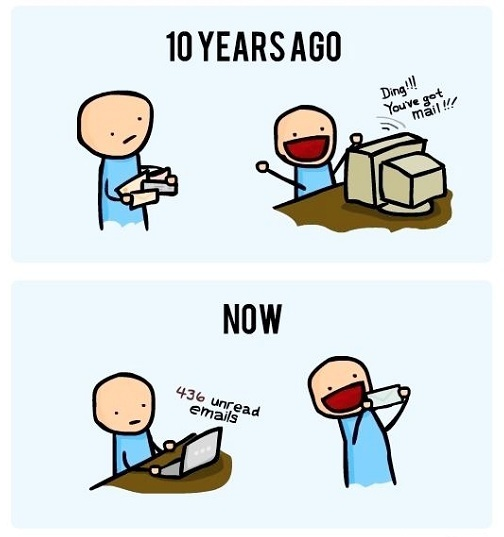Email vs Direct Mail Comparison
The following is a summary that was recently published by the American Direct Marketing Association
KEY FINDINGS
Email to an “in-house” list averaged:
- 19.47 percent open rate;
- 6.64 percent click-through rate
- 1.73 percent conversion rate; with a bounce-back rate of 3.72 percent and an unsubscribe rate of 0.77 percent.
Response rates for Direct Mail have held steady over the past four years. Letter-sized envelopes, for instance, had a response rate this year of 3.42 percent for a house list and 1.38 percent for a prospect list.
Catalogs had the lowest cost per lead/order of $47.61, just ahead of inserts at $47.69, email at $53.85, and postcards $75.32.
Outbound telemarketing to prospects had the highest cost per order or lead of $309.25, but it also had the highest response rate from prospects of 6.16 percent. The highest response rate for a house list was also telephone, at 10.41 percent.
Paid search had an average cost per click of $3.79, with a 3.81 percent conversion rate. The conversion rate (after click) of internet display advertisements was slightly higher at 4.43 percent.
Response rates for B-to-B campaigns were generally higher than for B-to-C campaigns. Lead generation and high-end average sale campaigns also had higher response rates.
Nearly 60 percent of direct mail campaigns in financial services aimed to produce a direct sale. The average response rate was a comparatively low 2.66 percent to a house list and 1.01percent to a prospect list.
One reason why direct mail continues to be a go-to strategy for direct marketers is that improvements in printing and database technology as well as analytic have allowed direct mail and other offline media to deliver consistent response rates.
B-T-B / BUSINESS TO BUSINESS MARKETING
Direct mail and e-mail still top the list of most used media for business-to-business marketers, according to a new survey from the Direct Marketing Association (DMA).
According to the DMA’s 2010 Response Rate Report direct mail and e-mail were each used by 67%of B-to-B services respondents. Trailing with less than 5% each were DRTV (4%), mobile (4%) and fax (1%).
Yory Wurmser, American Direct Marketing Association Research Manager, says one of the biggest surprises for him in the B-to-B data was the fact that B-to-B response rates for direct mail overall were higher than B-to-C. The average response to a B-to-B house file letter-sized envelope mailing was 4.28%, versus 3.03% for B-to-C.
Looking at dimensional mailings (non-flats in boxes or large packages, often containing samples or gifts), the gap was even wider: the average house file response in B-to-B was a whopping 8.51%, compared to only 3.52% for B-to-C.
This could be because consumer-targeted mailings are typically geared to generate sales while B-to-B pieces are often focused more on lead generation, says Wurmser. “That could explain the higher response rate.”
The continued popularity of the mail in B-to-B didn’t surprise Wurmser.
“Direct mail is still a workhorse,” he notes, adding that while volumes might dip, budgets for direct mail will likely remain flat or even inch up a bit.
The majority of B-to-B services respondents (63%) used two-to-five customer segments for their average mailing; 27% didn’t segment, 6% used more than five segments and only 4% were doing personalized mailings.
The typical desired outcome to a B-to-B services mailing was a direct sale for 35% while 29% cited driving a prospect to a Web site for more information. Other outcomes included:
- Sign up for an offer 8%
- Sign up for free newsletter/custom publication 6%
- Consent to receive sales collateral 6%
- Sign up for free trial 2%
- Other 13%
COSTS PER LEAD HIGHER, TOO
But while B-to-B response rates for mail were higher across the board, so were the costs per lead or order. That figure for a letter-sized mailing was $69.76 in consumer, versus $135.56 in B-to-B. And as in response rates, the gap for dimensional mailings was dramatic—a $45.71 cost per order for consumer and $244 for B-to-B.
Wurmser cautioned that the number of respondents to the dimensional mail question was low, so that should be taken into account. “But B-to-B packages always tend to be more elaborate. You can’t just send someone a little trinket. I’ve seen B-to-B packages that included rare bottles of Scotch.”
The cost per click for paid search in B-to-B was also higher than in B-to-C. Conversion rates were better in B-to-B—5.27% versus 3.63% in consumer—but the average CPC was $4.59, versus $3.79 in consumer. This, theorized Wurmser, is because B-to-B marketers are usually bidding on more targeted keywords.
“They’re often trying to reach a very specific, often C-level audience, so they’re willing to spend more per click,” he says.
Not surprisingly, the highest ranking desired outcome of a B-to-B services paid search campaign was to get the prospect to visit a Web site for more information (53%), followed by generate a direct sale (27%).
E-MAIL MARKETING / TELEMARKETING METRICS
Looking at e-mail, the average B-to-B house file open rates were 19.85%, compared to 18.5% for consumer marketers. B-to-B house file click-throughs were 7.26%, versus 6.07% in B-to-C.
E-mail acquisition costs were higher in B-to-B when looking at house files—$11.97 versus $8.73 for consumer. But when looking at prospect files, B-to-B seems to be finding bargains, clocking in at $15.71 versus $78.88 on the consumer side.
In outbound calling, B-to-B marketers doing cross-selling or up-selling saw an 8.12% response rate, and a $9.83 cost per contact, versus 6.84% and $4.57 for consumers. When calling prospects, B-to-B marketers reported a 5.48% response and a $20.23 cost per contact, compared to 4.06% and $21.59 in B-to-C.

Get a quotation or advice from an expert. Call us on (03) 9574 6566.
We love sharing our experience.